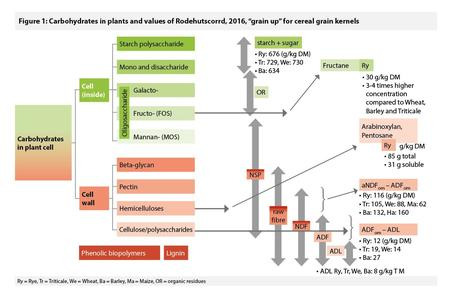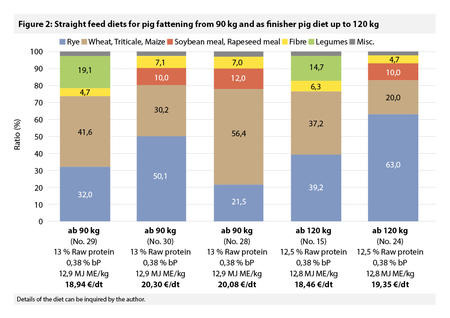International
Healthy and happier pigs due to fibre?
In human nutrition it is often discussed that a wholesome and fibre-rich diet containing a good mixture of our natural dietary diversity is the best way to stay healthy and feel well. Does it also apply to pigs? An article by Dr. Wilke Griep.
Is it possible to make pig feeding better and more sustainable by using more diverse and nutrient reduced mixtures? In humans, fibre has a positive effect on digestion and health. In what way can this knowledge be applied to pig nutrition?
Is it necessary to revaluate fibre in pig feeding?
Antinutritional factors limit straight feed usage
Apart from supplying ENERGY and essential nutrients and substances pigs also obtain through their feed substances which are cheap but can also have an antinutritional to toxic effect. In the past, the main focus was on preventing toxic effects and on minimising antinutritional effects (effects that reduce the nutrition efficiency). Therefore, in common practice rye has a maximum share in the diet of 10 % for farrows, 25 % for sows and up to 50 % for grower/finisher pigs. Of course, thresholds for ergot and mycotoxins are considered in regard to using rye in human as well as in animal nutrition in order to CONTROL toxicity risks.
Carbohydrates are not just delivering ENERGY!
Apart from easily digestible sugars and starch cereal grain kernels also contain non-starch polysaccharides (NSP) and oligosaccharide (OSc), which are also carbohydrates. They are bigger sugar molecules which are composed of a few (oligo) or many (poly) simple sugar (monosaccharide) units. If monosaccharides contain 5 instead of 6 carbon atoms they are referred to as pentose (Figure 1). The most important elements of pentoses are The pentoses D-xylose and L-arabinose, which are also called arabinoxylan or hemicellulose, are the most important elements of pentosans. This group of substances is mainly found in the bran of cereal grain kernels. The bran, which also consists in major parts of cellulose, lignin and other NSP and OSc, protects the germ and nutrient reserves due to its mechanical and chemical stability. Cellulose, lignin and pentoses are hard to digest or indigestible for digestive enzymes of higher organisms. Thus, grain kernel brans are feed components which are difficult to digest.
In comparison with other cereals rye grain kernels have a noticeable high content of arabinoxylan in the order of 85.4 g/kg DM of which about 36% are water-soluble. Due to the good swelling capacity and water-solubility of pentosans rye baking flour gains more viscoelastic dough properties.
Pentosans are also described as mucin as they increase the digesta viscosity. Pentosan faeces become gluey/mucous slowing down the intestinal passage and therefore feed uptake and growth intensity. Especially for poultry and to a limited extent for pigs high pentosan contents can be antinutritional. Rye significantly differs from other cereals due to a higher viscosity.
Enzymes, which do not break down non-starch polysaccharides, can be added to the diet in order to achieve an optimal viscosity, feed uptake, digestibility and ENERGY use.
Structural carbohydrates still have other functions!
Nowadays, more than ever performance orientated feeding takes fibre into account as part of the diet formulation and uses it to optimise compound feed. Fibre is not so important to the animal as an ENERGY and nutrient supplier but as gut filler and substrate for benign microbes in the digestive tract. It helps to establish a healthy gut flora and improves intestinal health while also having a positive influence on animal behaviour.
Filler: Fibre with high swelling and water binding capacity has a filling and comforting effect. Fibre also contributes to increase the intestinal passage and belongs to the preventative measurements to avoid constipation and MMA in sows at farrowing time. Gestating sows need occupation and filling at a comparatively low nutrient requirement. Fibre causes animals to chew their feed more intensive and
chemotaxis imparts a feeling of fullness due to the fibrous and more voluminous feed. Piglets, fatting pigs and lactating sows have a more stable health and develop less behavioural problems like cannibalism and are less aggressive if fibre is chewed and taken up.
Microbial substrates: Structural and fiberous carbohydrates present in the small intestine such as pentosans and fructans are difficult to digest. Therefore, their nutritional value for the pig is rather low. However, they act as substrate for benign microbes (e.g. bifidobacteria) in the colon. If enough undigested pentosans and fructans arrive with the digesta in the colon a microbial flora builds up which increasingly forms and releases short-chain fatty acids like butyric acid (butyrate) and lactic acid (lactate). Especially lactic acid contributes to an acid environment in the digestive tract and helps to CONTROL pathogenic germs. Butyrates nourish the intestinal mucosa and contribute to the development of a healthy, strong intestine with a lower risk of boar taint and salmonella gut infestation. Intestine cell walls are also altered in a way that nutrients can be more efficiently absorbed and used.
Animal welfare/ performance: Rye provides more pentosans and fructans than any other cereal. That means that fibre in rye has a positive effect on animal welfare, animal health and performance. Therefore, straight feed like rye not only deliver ENERGY and lysine rich protein but because of their effects on the intestinal flora improve intestine health, animal welfare and performance efficiency. Microbiological research confirms that the typically higher contents of fructans and arabinoxylans in rye which are its fibres have a more favourable effect on the intestine health than triticale.
Example of a N and P reduced diet in pig fattening
The feed consumption is at its highest level throughout pig fattening during the period of finishing pigs. Objectives like using feedstuff cost-efficient and sustainable become most important at this stage. Minimising health and stress risks also gain in importance as losses are more serious with a higher economic impact.
Figure 2 shows the content of N and P reduced diets for finisher pigs. On the base of producer and commodity prices taken in the period of February to May 2018 in North-West Germany the optimisation results always have a high ratio of rye. Thus, no minimum or maximum cereal requirements were given. Diets with oilseed meal are more expensive than the ones with legumes.
All diets fulfill in terms of the seven most essential amino acids the requirements of the amino acid spectrum in regard to the pre-caecal amino acid digestibility. Taking the effect of added phytase into account a sufficient supply of digestible phosphorous (vP) is guaranteed at a level clearly over 2.0 gvP/kg.
Summary
As antinutritional factors in feedstuff structural carbohydrates have the potential to change the viscosity for pigs and therefore to slow down the intestinal passage influencing feed uptake and usage negatively. Suitable NSP splitting enzyme supplements help to achieve an optimal viscosity. Recent results also show that the structural carbohydrates of rye have a significantly positive influence on intestine health both in the nutrition of pigs and humans.
The examples of N and P reduced finisher pig diets show that rye in pig fattening can be competitive while also supporting animal welfare and health. Rye contributes to more sustainable pig fattening!




